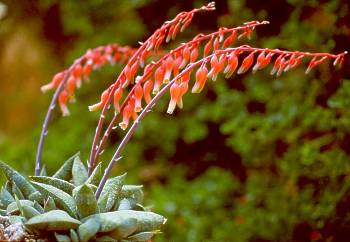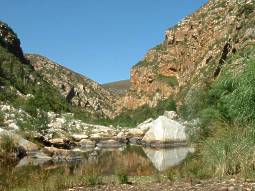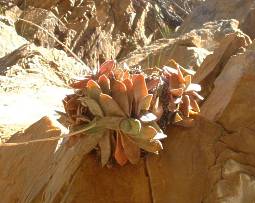Gasteria glauca
Gasteria glauca Van Jaarsv.
Family: Asphodelaceae
Common names: Kouga River gasteria (Eng.); Kouga-beestong (Afr.)
Introduction
Gasteria glauca is a small aloe-like plant with highly succulent, glaucous (grey-green) leaves arranged in a dense rosette. It grows on cliff faces overlooking the Kouga River of the Eastern Cape Province and is one of the most easily grown of all gasterias.

Description
Description
A small succulent plant proliferating from the base to form dense rounded clusters up to 250 mm in diameter. The roots are up to 2 mm thick. The leaves at first grow in two opposite rows (distichous), later becoming a dense rosette. They are 50-70 mm long and 15-18 mm in diameter at the base, firm but brittle, tongue-shaped, tapering towards the ends, straight but sometimes sickle-shaped (falcate), ending in an acute sharp point (mucronate). The inner leaves grow erect, the outer ones are spreading. Their upper surface is flat, becoming slightly channelled during dry conditions. The lower surface is rounded at the base but has a distinct keel. They are grey-green (glaucous) and rough due to raised tubercles.

The leaf margins are beset with horny white tubercles. When becoming detached the leaves will root and form new plantlets.The inflorescence is a simple raceme up to 250 mm long. The flowers are tubular and pendulous (hanging downwards) on stalks up to 7 mm long. The flowers are 30-43 mm long, with the belly-shaped (gasteriform), reddish pink basal portion up to 10 mm in diameter; the narrow upper portion is greenish yellow to yellow. After fertilization, the flower stalks (pedicels) become stiff, and the capsules, which are oblong and up to 20 mm long and 8 mm in diameter, are held erect. The flattish seeds are blackish, 3 mm long and 2 mm wide.
Gasteria glauca differs from other species of the genus by its leaves which are distinctly glaucous (grey-green) and often sharply pointed. It is related to G. ellaphieae, a well camouflaged crevice dweller from the Kouga Dam area and further to the east.
Conservation Status
Status
Gasteria glauca, although only known from a small region in the Eastern Cape, is well protected by its inaccessible habitat. The plant has been well established in cultivation (ex situ conservation) and is grown by succulent plant growers all over the world.

Distribution and habitat
Distribution description
Gasteria glauca is restricted to the Kouga River region. It occurs in a gorge adjacent to Guerna Kop growing in crevices and on ledges of sheer, east-facing aspects on mineral-poor quartzitic sandstone soil on the Kouga Mountains overlooking the Kouga River. Rainfall occurs during both winter (cold fronts) and summer (mainly thunder showers) and amounts to about 500-600 mm per annum. The average daily maximum temperature is about 26°C and the average daily minimum temperature is about 11°C. Winters are cooler but frost is rare or absent. Gasteria glauca grows at an altitude of more or less 400-800 m in Gamtoos Thicket of the Albany Thicket Biome (Mucina & Rutherford 2006). It shares its habitat with other cliff-dwelling plants such as Haworthia gracilis var. picturata, H. viscosa, Cyrtanthus montanus, Plectranthus verticillatus, Othonna triplinervia, Crassula lactea and Lampranthus affinis.
Derivation of name and historical aspects
History
The specific epithet 'glauca' pertains to the grey-green (glaucous) leaf colour. Gasteria glauca was named in the American Cactus and Succulent Journal in 1998 from plants collected by Rob Welsh and Ernst van Jaarsveld on an expedition exploring the Kouga River in 1997.
Ecology
Ecology
Gasteria glauca grows on sheer, south-facing cliffs and rock ledges. The glaucous colour of the leaves (covered in a waxy substance) ensures efficient protection against moisture loss. Gasteria glauca flowers during summer (January-February, in the southern hemisphere) and is pollinated by sunbirds. The seeds are dispersed by the wind.
The seeds ripen during late summer which coincides with the rainy season. Like many other Gasteria species its leaves are brittle, and will proliferate when they have fallen into a crevice.
Gasteria glauca is one of seven Gasteria species which have made cliffs their main habitat. The others are Gasteria batesiana, G. glomerata, G. doreeniae, G. croucheri subsp. pendulifolia, Gasteria pillansii var. ernesti-ruschii, G. pillansii var. hallii and G. rawlinsonii.
Uses
Use
The species is used in horticulture but not medicinally.

Growing Gasteria glauca
Grow
Gasteria glauca is a worthwhile introduction to horticulture and is very easily grown, particularly as a pot plant. It is a prolific grower and its stoloniferous nature soon ensures a dense cluster. Gasteria glauca is a slow grower, and out-of-doors it is best cultivated in dry Mediterranean type gardens where frost is not too severe. It thrives on rockeries or steep embankments. Plants prefer partial shade, and in hot climates they should therefore be protected from full sun. Plants should reach flowering size in about three years.
Propagation
Gasteria glauca is easily propagated from seed, by division or leaf cuttings. It is best to apply a fungicide when grown from seed. Sow seed during spring or summer in a warm, shady position in a sandy slightly acidic soil and keep moist. Cover with a thin layer of sand and keep moist. Germination is usually within 3 weeks. Seedlings grow slowly and are best planted out about a year after sowing. Leaf cuttings are best taken in spring; leaves of about 60-100 mm length are ideal. Allow the leaf cutting to form a heel by placing it on a dry window sill for a week or three. Cuttings are best rooted in clean sand. Once rooted plants can be planted into individual containers, preferably in a sandy, slightly acidic, soil mixture. Plants react well to organic feeding (compost or any liquid fertilizer). Gasteria glauca can be watered at any time of the year. Watering during winter should be reduced, but during long, dry, hot spells provide a good watering.
References
- MUCINA, L. & RUTHERFORD, M.C. (eds) 2006. The vegetation of South Africa, Lesotho and Swaziland. Strelitzia 19. South African National Biodiversity Institute, Pretoria.
- VAN JAARSVELD, E.J. 1994. Gasterias of South Africa. Fernwood Press.
- VAN JAARSVELD, E.J. 1998. A new taxon, and new combinations in the Gasteria carinata complex Cactus and Succulent Journal (U.S.) 70, 2: 65-71.
- VAN JAARSVELD, E.J. 2007. The genus Gasteria: a synoptic review (new taxa and combinations). Aloe 44:4:2007: 84-102.
Credits
Kirstenbosch National Botanical Garden
Ernst van Jaarsveld
November 2009
Plant Attributes:
Plant Type: Succulent
SA Distribution: Eastern Cape
Soil type: Sandy
Flowering season: Early Summer
PH: Acid
Flower colour: Pink, Orange
Aspect: Shade, Morning Sun (Semi Shade)
Gardening skill: Easy
Special Features:
Horticultural zones








Rate this article
Article well written and informative
Rate this plant
Is this an interesting plant?
Login to add your Comment
Back to topNot registered yet? Click here to register.